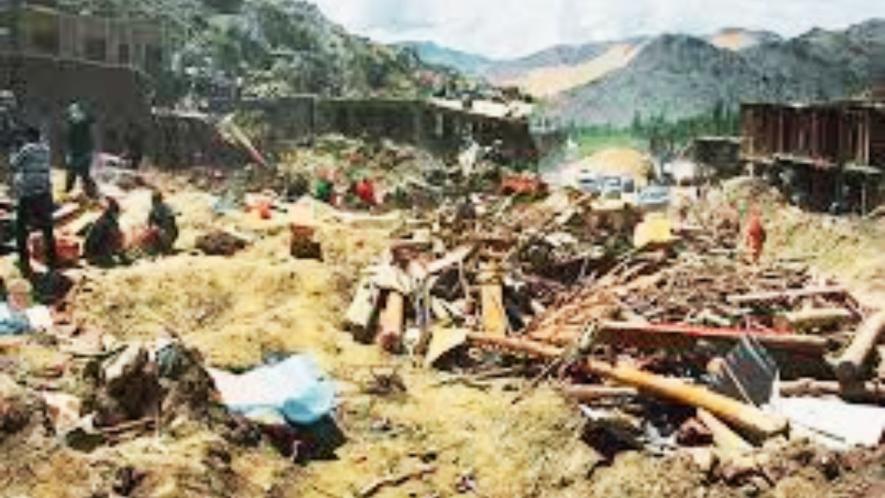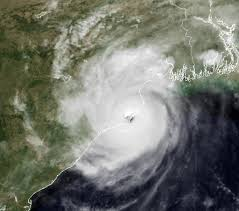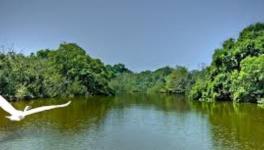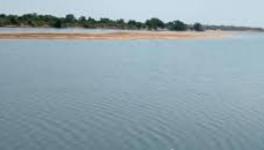Ominous October in Odisha: How Nature Gets Run Down, and Hits Back

Come October, Odisha recollects the calamitous phases of tidal invasions from the coast of Bay of Bengal. This year signals a few ominous signs, as since the past two months, the state has been witnessing over a dozen low pressure episodes accompanied with deep depressions, almost unbalancing climatic behaviour. That still continues.
The 480-km-long Odisha coastline has been vulnerable to a few major tropical cyclones, among which the 1999 Supercyclone on October 29, was the most calamitous, nearly pulverising over 14 districts and turning thousands of human habitations into graveyards.
Its intensity lasted over 36 hours with wind velocity reaching up to 260 kmph.
Eyewitness accounts then revealed that the sea tides rose to a height of 25 to 30 meters and when they splashed down, hardly anything on the ground could withstand the impact and perished -- be it humans or livestock or birds.
The evening at Erasama, the ‘Eye of the Storm’, in Jagatsinghpur, where this reporter had to stay the night at the Tehsil office on October 31, was tranquil. Besides the humming of surviving nocturnal insects, it was so tranquil that even water from a bottle poured into the mouth was resonating in the room. The entire Erasama was emitting an otherworldly feel.

Preceding the 1999 Supercyclone, it is worth recalling that the cyclone (not named) that hit Odisha coast in 1971, on October 30, was no less a blitzkrieg in its ferocity. Although the wind velocity was 115 Kmph, the lingering churning of the tides spelt disaster.
The ‘eye of the storm’ was a location close to the coast called Satavaya (a cluster of seven villages) of which five villages were literally swept away into the sea, leaving just two villages along the coast.
A lesson from nature that humanity still refuses to learn is that ruthless exploitation of nature results in perils beyond human control.
The major cyclones hitting the Odisha coast between 1971 and 2024 include the devastating 1971 cyclone (which killed 11,000 persons), the 1999 Supercyclone that claimed over 10,000 lives, and more recent storms like 2013's Phailin on October 4, 2014's Hudhud- October 8, 2018's Titli in October 8, 2019's Fani in October, and 2021's Yaas. Other significant events include Cyclone Jawad, Gulab, Remal and Dana, all of which affected the coast. And Matmo and Bulbul in October & November, respectively.
Sea erosion has been affecting a significant portion of the Odisha coast, leading to the loss of land, destruction of villages, and displacement of communities due to factors like rising sea levels, intensified cyclones, and human activities such as upstream constructions etc and illegal agricultural activities.
In fact, this part of coastal Odisha has a vast cover of mangroves, perhaps, the second largest in the country after Sundarbans in West Bengal.
“Mangroves and other tree species here act as formidable barriers against the tidal invasions. But, their gradual or rather rapid depletion in the past two decades due to several activities like shrimp culture, firewood, and even paddy cultivation etc., have exacerbated the depletion,” said Biswajit Mohanty, an environmental activist.
“This is one of the major reasons behind coastal erosion thus increasing the vulnerability of the areas”, Mohanty told this writer.
Besides excess human population along the coast, the rapid depletion of green cover is expediting the rate of coastal erosion.

According to the National Centre for Coastal Research (NCCR), as of early 2025, about 25.6% (or, say, 140.72 km) of coastline suffered erosion between 1990 and 2018.
“However, a separate data set from 2024 show the erosion percentage as high as 50% which is a cause of worry and needs to be addressed on a war footing, else tidal invasions can become more frequent”, said Mohanty.
Reports in The Indian Express newspaper have identified several areas severely impacted by coastal erosion, including the cluster of Satabhaya, as mentioned earlier, which had been critically affected by the rise in sea level and erosion that had washed away several villages, in 1971.
“The same can be said about other coasts in Balasore, Puri and Ganjam districts that are facing significant erosion and frequent low pressures and deep depressions, which have now become a new normal,” Mohanty noted.
The heavy load of human habitation along the coast was manifested in the1999 Supercyclone, a catastrophe that the people of Odisha can never forget.
At a time when the world is observing the World Wildlife Week from October 2 to October 8 2025, imagine the plight of innumerable wildlife species along the coast and tidal creeks when an oceanic storm hits.
As October begins, even low pressures in the Bay of Bengal cannot be ignored as ‘normal course’ along the coastlines.
The writer is a freelancer based in Odisha with over 40 years’ experience in the profession.
Get the latest reports & analysis with people's perspective on Protests, movements & deep analytical videos, discussions of the current affairs in your Telegram app. Subscribe to NewsClick's Telegram channel & get Real-Time updates on stories, as they get published on our website.
























